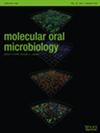Prevalence of antibiotic resistance genes in the oral cavity and mobile genetic elements that disseminate antimicrobial resistance: A systematic review.
IF 2.8
3区 医学
Q1 DENTISTRY, ORAL SURGERY & MEDICINE
引用次数: 11
Abstract
OBJECTIVE To assess the prevalence of antibiotic resistance genes in the oral cavity and identify mobile genetic elements (MGEs) important in disseminating them. Additionally, to assess if age, geographic location, oral site, bacterial strains and oral disease influence the prevalence of these genes. METHODS Three electronic databases (Medline, Embase and the Cochrane Library) were used to search the literature. Journals and the grey literature were also hand-searched. English language studies from January 2000 to November 2020 were selected. Primary screening was performed on the titles and abstracts of 1509 articles generated. One hundred and forty-seven full texts were obtained to conduct the second screening with strict inclusion and exclusion criteria. RESULTS Forty-four final articles agreed with the inclusion criteria. Half of the studies were classed as low quality. tet(M) was the most prevalent gene overall and the conjugative transposon Tn916 the most common mobile genetic element associated with antibiotic resistance genes in the oral cavity. In babies delivered vaginally tet(M) was more prevalent, whilst tet(Q) was more prevalent in those delivered by C- section. Generally, countries with higher consumption of antibiotics had higher numbers of antibiotic resistance genes. Agricultural as well as medical use of antibiotics in a country should always be considered. Between healthy, periodontitis and peri-implantitis subjects, there was no difference in the prevalence of tet(M) however erm(B), tet(M) and tet(O) was higher in carious active children than the non-carious group. Subjects with poor oral hygiene have more pathogenic bacteria that carry resistance genes compared to those with good oral hygiene. E. faecalis isolates demonstrated significant tetracycline resistance (tet(M) up to 60% prevalence in samples) and erythromycin resistance (erm(B) up to 61.9% prevalence in samples), periodontal pathogens showed significant beta-lactam resistance with blaZ and cfxA present in up to 90-97% of samples and the normal oral flora had a high level of erythromycin resistance with mef(A/E) present in 65% of S. salivarius isolates. The most common resistance gene was tet(M) in root canals, cfxA in subgingival plaque erm(B) in supragingival plaque and tet(W) in 100% of whole saliva samples. CONCLUSIONS The review highlights that although many studies in this area have been performed, 50% were classed as low quality. We advise the following recommendations to allow firm conclusions to be drawn from future work: the use of large sample sizes, investigate a broad range of antibiotic resistance genes, improved methodologies and reporting to improve the quality of genetic testing in microbiology and randomisation of subject selection. This article is protected by copyright. All rights reserved.口腔中抗生素耐药基因的流行和传播抗菌素耐药性的可移动遗传因子:系统综述。
目的评估口腔中抗生素耐药性基因的流行情况,并确定在传播中起重要作用的移动遗传元件。此外,评估年龄、地理位置、口腔部位、细菌菌株和口腔疾病是否影响这些基因的流行。方法采用三个电子数据库(Medline、Embase和Cochrane Library)检索文献。期刊和灰色文献也被手工搜索。选择2000年1月至2020年11月的英语学习。对生成的1509篇文章的标题和摘要进行了初步筛选。获得147篇全文进行第二次筛选,并有严格的入选和排除标准。结果最后四篇文章符合入选标准。一半的研究被归类为低质量研究。tet(M)是最普遍的基因,偶联转座子Tn916是口腔中与抗生素抗性基因相关的最常见的移动遗传元件。在阴道分娩的婴儿中,tet(M)更为普遍,而tet(Q)在剖腹产的婴儿中更为普遍。一般来说,抗生素消费量较高的国家具有较高数量的抗生素耐药性基因。在一个国家,抗生素在农业和医疗上的使用都应该考虑在内。在健康、牙周炎和种植体周围炎受试者之间,tet(M)的患病率没有差异,但患龋活动的儿童的erm(B)、tet(M)和tet(O)高于非患龋组。与口腔卫生良好的受试者相比,口腔卫生较差的受试对象携带耐药性基因的致病菌更多。粪大肠杆菌分离株表现出显著的四环素耐药性(样品中tet(M)高达60%的患病率)和红霉素耐药性(样本中erm(B)高达61.9%的患病率,牙周病原体表现出显著的β-内酰胺耐药性,高达90-97%的样本中存在blaZ和cfxA,正常口腔菌群具有高水平的红霉素耐药性,65%的唾液酸链球菌分离株中存在mef(a/E)。最常见的耐药基因是根管中的tet(M),龈下牙菌斑中的cfxA,龈上牙菌斑中的erm(B)和100%全唾液样本中的tet(W)。结论:该综述强调,尽管在这一领域进行了许多研究,但50%的研究被归类为低质量。我们建议以下建议,以便从未来的工作中得出坚定的结论:使用大样本量,调查广泛的抗生素耐药性基因,改进方法和报告,以提高微生物学中基因检测的质量,并随机选择受试者。这篇文章受版权保护。保留所有权利。
本文章由计算机程序翻译,如有差异,请以英文原文为准。
求助全文
约1分钟内获得全文
求助全文
来源期刊

Molecular Oral Microbiology
DENTISTRY, ORAL SURGERY & MEDICINE-MICROBIOLOGY
CiteScore
6.50
自引率
5.40%
发文量
46
审稿时长
>12 weeks
期刊介绍:
Molecular Oral Microbiology publishes high quality research papers and reviews on fundamental or applied molecular studies of microorganisms of the oral cavity and respiratory tract, host-microbe interactions, cellular microbiology, molecular ecology, and immunological studies of oral and respiratory tract infections.
Papers describing work in virology, or in immunology unrelated to microbial colonization or infection, will not be acceptable. Studies of the prevalence of organisms or of antimicrobials agents also are not within the scope of the journal.
The journal does not publish Short Communications or Letters to the Editor.
Molecular Oral Microbiology is published bimonthly.
 求助内容:
求助内容: 应助结果提醒方式:
应助结果提醒方式:


